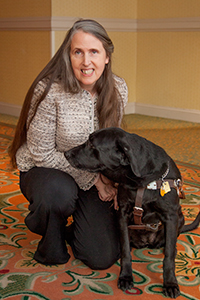Stopping at booths in the CSUN exhibit hall last week, I saw a lot of innovative problem-solving. One of the problems I saw companies trying to solve was, simply put, how to make smart phones more usable for people who are not really users of technology, and who are blind or visually impaired.
These solutions, in the exhibit hall this year at least, mainly centered around the use of the Android, with suites of applications "on top" of the usual operating system. Some of these solutions altered or added to the hardware, as well.
The BraillePlus 18 PDA from the American Printing House for the Blind is such a device. It has a braille display and buttons, with no display and no touch screen. I managed to handle the notetaker, but never did get to see it in action—apparently the demonstration model was running some very pre-release alpha version of the software.
Telorion has an overlay that gives specific Android phones a tactile overlay, so there is no doubt where the numbers and other buttons are. They combine this with a suite of software and this combo makes dialing the phone very easy and familiar — just push the "buttons" the way you would on a mobile phone that had buttons.
The latest version of RAY G300, reviewed last summer in AccessWorld magazine, has yet another approach to the problem of "untechnical" users and the need for a fully-featured phone. This one also runs a suite of custom apps on top of everything, again with speech built in, but no extra hardware. RAY has a simpler dialing and menu-selecting technique than the Android with Talkback gives.
In both these latter cases, I asked if the user could quit the custom applications and go to using the Android phone with Talkback as the techier user might, and they assured me that users could graduate to that at any time.
